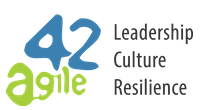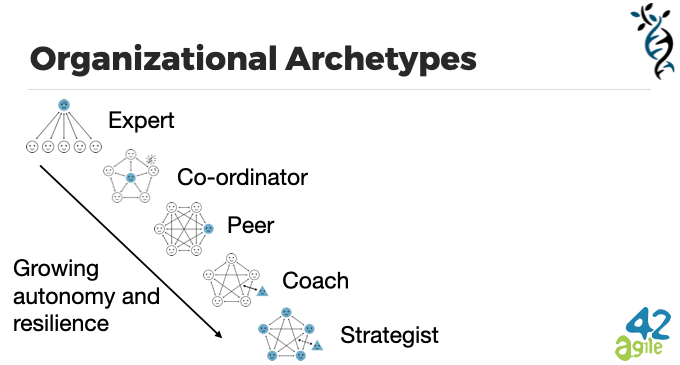Organizational Culture: Why it Matters and How to Improve it
Company culture is often associated with having a ping pong table in your office, after-work drinks on a Friday, or a framed value statement on your wall. But organizational culture is so much more than that; it is the driving force behind innovation, growth, and sustainability. In this article, we will explore different types of organizational culture that exist and the signs of a toxic one, plus how you can work towards a culture that is more aligned with your goals.
What is Organizational Culture?
Organizational culture refers to the shared values, beliefs, attitudes, behaviors, and practices that characterize an organization. It’s the “how we do things around here,” and it can make or break your company.
Culture is a set of norms and customs that shape the way people interact with one another in an organization. It is reflected in how you make decisions and accomplish tasks within the business. It is often described as the “personality” of an organization, and it can vary widely depending on factors such as the industry, company size, leadership style, and geographic location.
Why is Organizational Culture Important?
Organizational culture influences the overall work environment, employee motivation, and the organization’s ability to achieve its goals. When you have a bad company culture, it can cause negative behaviors in the workplace, and these come at a cost. The longer these problems persist, the more expensive and difficult they will become to fix.
According to GALLUP’s recent workplace report, 67% of employees are not engaged, and research (PDF file) suggests that 79% of employees who quit their jobs cite a lack of appreciation as a key reason for leaving. High employee turnover is a key symptom of a toxic organizational culture. According to the Society for Human Resource Management, this phenomenon has cost US businesses over $223 billion in the last five years.
The effects of a bad company culture were seen recently during The Great Resignation. During the Great Resignation, employees started to voluntarily quit their jobs at an elevated rate. After the COVID-19 pandemic loosened its grip on people’s personal and work lives, they had time to re-evaluate their careers, long-term goals, and how work fits into their lives. Organizations were forced to rethink and renew their cultures so that they could win the battle to attract and retain talent. And while we may no longer be feeling the imminent effects of The Great Resignation, there has been a “hidden resignation wave,” also known as “quiet quitting.” In this phenomenon, people remain in their jobs but are disengaged and unproductive.
When you consider this alongside the concept of burnout, another symptom of an unsustainable culture, you’re left with a scary picture. For a company to be successful in the long run, they need to learn from the lessons of the past. While it can be hard to put your finger on your organization’s culture, there are some tell-tale signs that you may have problems in this area.

Photo by ROMAN ODINTSOV on Pexels
Examples of Negative Behaviors in the Workplace
Teams Aren’t Trusted to Make Decisions
Management teams that don’t allow for autonomy, especially when it comes to decision-making, can leave people feeling stifled. It also destroys trust. As a result, the quality of work will suffer and teams may have negative feelings about management styles or a particular manager.
Leaders Have a Fixed Leadership Style
Agile leadership requires us to make sense of a situation before we respond, so that our behaviors are coherent with the group of people we are leading and their specific context. If leaders fail to do this, it can leave the team feeling frustrated and distrustful.
The Team Lacks Purpose and Direction
To feel driven and motivated in the workplace, we need to be working towards bigger goals. It is crucial that companies communicate these goals and are transparent about them. And then allow people to organize around them.
The Team Seems Scared to Fail
Organizations should encourage people to voice their opinions, experiment, and take on new projects. A side effect of that will almost certainly be a failure, and your organization should be embracing this as part of the process. If your organization is not encouraging these types of behaviors, then you can’t change, grow, or learn in the process.
People Feel Burned Out
If there is a sense of burnout within the team or leadership, it could mean that individual values aren’t aligned with those of your company. This can leave people feeling drained.
Bad Company Culture Examples
It is not a good sign if people are scared to speak their minds and problems only emerge at the last minute. When this happens it makes problems much more difficult and expensive to fix. While there are a lot of examples of toxic company culture in today’s world, here are some that our coaches have observed in large organizations.
A Culture of Blame
A culture of blame happens when no one takes accountability for mistakes in a team and passes them off to other team members. A sign of this is when there is a problem, the first thing that people ask is whose fault it is. We want people to take accountability for their actions in a way that promotes action. A culture of blame doesn’t allow for that as it triggers people’s defenses and creates a negative emotional reaction.
This is an entrenched behavior born from a place of wanting to protect ourselves from punishment. In a punishment and reward system, this is going to be the reaction. This type of culture does not promote collaboration or teamwork, instead it creates competitiveness and feelings of resentment.
We want to work in an environment that inspires action, and communication. So, instead of asking “Who did this,” we should start by asking, “How are we going to fix this?”; “Who needs to be involved?”; and, “What could we try that we haven’t tried before?” or “How can we reduce the impact of this?” Here, we are galvanizing action instead of inaction and defensiveness.

Photo by Lukas on Pexels
Management by Fear
This type of behavior enforces a chain of command and puts pressure on employees to be obedient. Some leaders may not be intentionally creating this kind of behavior. For example, if a manager shouts at his team and criticizes their work, but then talks about how they need to create a safe-to-fail environment, then his actions and words are in conflict with one another. As a result, they hold no weight and offer no lasting integrity.
Leaders should create space to really listen to their teams or colleagues. The conversations that happen while leaders or management figures are present shouldn’t be completely different from the ones that teams have when they are not there. Employees should feel comfortable speaking the truth, regardless of who is in the room or who is cc’d in an email. When people are afraid to speak their minds, it can impact the growth, innovation, and overall engagement of employees. It also doesn’t encourage self-organization, collaboration, or creativity.
Before organizations embark on a journey to improve their company, they need to know exactly where they are going wrong and what people are saying about their company culture.
Want to understand your company culture? OrgScan is a tool that allows you to measure your culture and get real-time feedback.
How can we Understand Company Culture?
While there may be many signs that your culture is not where it needs to be, it can be hard to understand the current status quo. And it is harder still to figure out how you can influence it. A lot of companies only look at the surface level of company culture (the actions that people perform) but to truly understand it, we need to dig a little deeper.
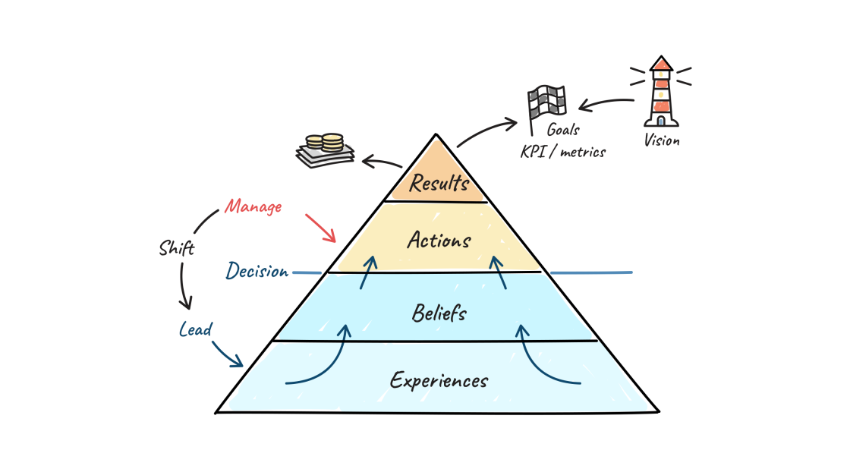
The results pyramid describes the relationship between results and experiences. To reach a vision or goal, companies rely on the actions of their employees and how these are completed every single day. Our actions are rooted in our beliefs, and our beliefs are shaped by the experiences that we have. Our brain is a connecting machine and has created patterns for us to interpret the realities in front of us based on all of our previous experiences. The problem here is that managers focus on managing people’s actions, and this is further reinforced by role descriptions and company processes. If companies do this, then they are only looking at the tip of the iceberg. To make a real and lasting impact, we need to understand what lies below the surface. Especially in a volatile, uncertain, complex, and ambiguous (VUCA) world where things are constantly changing.
A Coherent Culture is Very Important
A lot of companies are also striving to have more Agile cultures, where they decentralize decision-making so that people closer to the problem can deal with it. This type of decision-making poses a threat to organizations as it may cause people to take actions that don’t deliver the results that a company necessarily wants. The only way to overcome this is to create a coherent culture.
A coherent culture is when people’s actions are aligned with their belief systems. For example, if a culture promotes trust and transparency, then people’s experiences need to mirror those values or beliefs. If not, they will be incoherent with one another and the company won’t grow in the direction that it wants. This is why companies should try to align rituals and beliefs with the company’s vision. If our beliefs are coherent with our actions, then it makes it possible for us to reach the goals that we want to achieve.

Photo by Pixabay on Pexels
Every company has different objectives. So, it is important to remember that there is no ideal culture but rather one that is more conducive to your goals or that fits the market that you currently find yourself in.
A culture that wants to promote innovation is very different from one that wants to keep costs down and promote efficiency. This idea is described in the Crossing the Chasm model, which describes the market dynamics that products face. On the one side of the chasm we have our innovators, and on the other side of the chasm, we have the late adopters. Our company’s position in relation to the chasm has an impact on our goals and vision. This can help to determine the type of culture we want and start to create the experiences that will create a coherent belief system and get us closer to our goals.
Different Types of Organizational Culture
If you find yourself wondering what type of culture you have, the Competing Values Framework is a good place to start, as described in the book Diagnosing and Changing Organizational Culture: Based on the Competing Values Framework. This established model describes organizational culture and takes organizational behaviors, approaches, beliefs, and values into consideration. This framework primarily focuses on which values are most important in an organization. It is important to note that no organizational culture is present in only one of the four quadrants. Any culture has characteristics of all four culture types but may be more dominant in one quadrant. Your company should be well balanced while being suited for the organizational purpose.
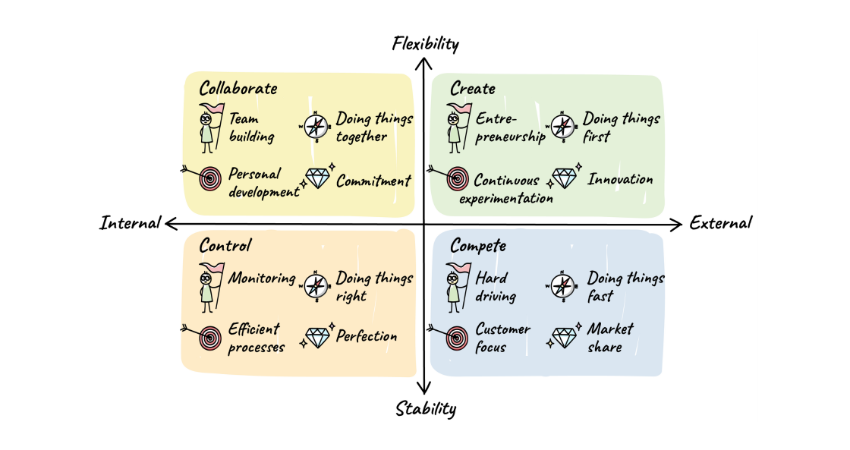
The Competing Values Framework
The Collaborate or Clan Culture
Focus: This type of culture is internally focused, geared towards diversification, and emphasizes collaboration.
Values: Organizations with this type of culture have a family-like attitude and like to achieve things together and in a sustainable manner. In this type of culture, it can take longer for people to make decisions.
Where you’ll find it: This type of culture is often prevalent in communities and universities.
The Create or Autocracy Culture
Focus: This type of culture also focuses on diversification, but this is externally focused. These are entrepreneurs, artists, visionaries, and disruptors.
Values: People in the organization are held together by their shared vision. They value innovation, risk-taking, and creativity. They want to be the first person to bring something to the market, and they are typically fast-paced, flexible, and experimental. However, they typically lack processes and routines.
Where you’ll find it: This type of culture is common in early-stage startups and the tech industry.
The Compete or Market Culture
Focus: This type of culture combines an external focus and a drive for standardization.
Values: People within a competitive culture are very much like athletes: hard drivers, focused on goal achievement and on short-term gains. They are results-driven and rely on getting things done quickly, rather than the sustainability of the future. They strive to increase profit or market share and may therefore fail to focus enough on people’s development and well-being.
Where you’ll find it: Typically, we would expect this type of culture in a sales organization or advertising agency.
The Control or Hierarchy Culture
Focus: In this culture, people strive for perfection and focus on assessing and measuring performance, controlling processes, finding ways to improve efficiency, and enhancing quality. This type of culture doesn’t take risks because failure is not an option that can hinder innovation.
Values: This type of culture values predictability and standardization. They like things to remain the same for as long as possible as they feel that if this is the case, then they will continue to be successful.
Where you will find it: We would expect this type of culture in an aircraft’s cockpit, an emergency room, or administrative offices.
How to Change Organizational Culture
Whilst there is no ideal culture, there is a culture that is more suited to your goals and what you want to achieve. The first thing that we need to realize is that we can’t design or build our company culture. This is because company culture is complex. Culture isn’t a blueprint – it’s a dynamic and ever-changing ecosystem. However, it can be shaped and influenced. So, how can we go about changing our culture?
Watch our Webinar: Shaping Company Culture.
Making Sense of Culture Through the Cynefin Framework
The Cynefin Framework is a sense-making framework that helps us to understand situations and how we can best respond. Within the framework, culture falls into the complex category. In the complex category, cause and effect can only be understood in hindsight. So, we need to probe and experiment, and then monitor the effects. Only then can we influence our culture.
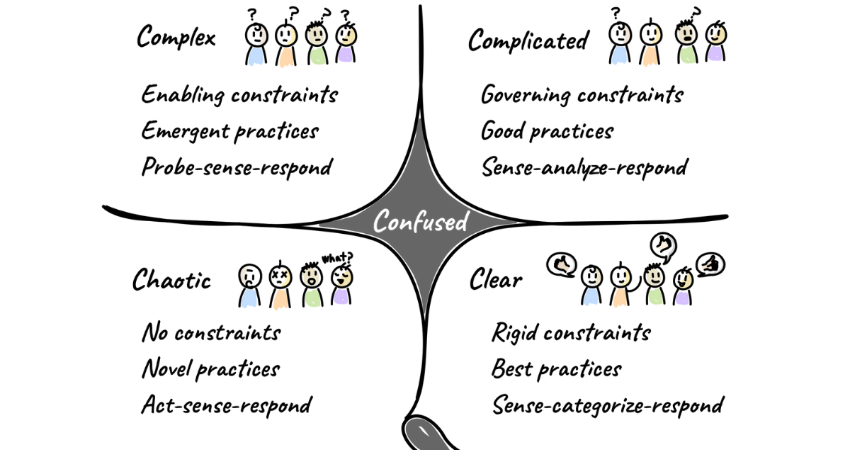
According to Cynefin, there are a few complex management techniques that we can use to nudge and influence our culture.
Make your Company Culture Visible
It is important to understand where you want to go, but it is even more important to know where you currently are. So, the first step is to understand your current culture and to make things and how decisions are made visible. If you make changes, such as trying a new leadership behavior, then you need to monitor how those changes affect the environment. This is why it is so essential to make culture explicit, as only then can you observe and measure changes that you initiate in an organization.
Distribute Change Agency in your Organization
Changing company culture can’t be done through a grand scheme and high-level initiatives, but it happens with multiple small initiatives that are spread throughout the organization. Every individual should be empowered to take action and influence behavior around them. Once everyone has an understanding of this and you make culture explicit, you can compare changes in different departments and understand what leadership behaviors caused these shifts in a team. In this way, you can see how culture is the responsibility of every single person in a company, not just leaders and managers.
Use the Vector Theory of Change
The last change complexity management technique that you can use is The Vector Theory of Change. Here, you can take different things into account when influencing behaviors. These include leadership behaviors, orientation towards work, theory of effectiveness, as well as value drivers and motivations. By using these factors, you can map out where you want to go and create more stories that you want and fewer of the ones that you don’t want. Here, the objective is not to dramatically change stories but rather to encourage people to take the path of less resistance to slowly accumulate more of the stories that they want.
Recommended reading: A real-life case study on how we helped a business change their organizational culture.
Leadership and Organizational Culture
In the Competing Values Framework mentioned above, it is clear that all dimensions influence each other, and that no organization is present in only one of the four quadrants. The different values that are present in an organization influence one another and should be aligned with the company’s goal or purpose. New patterns can be created through novel experiences. And this is where leadership can have a meaningful impact.
Introducing New Leadership Behaviors to Impact Culture
The only way that we can change behaviors and shift values is through leadership behaviors. By introducing new leadership behaviors, you can affect how people react and create new stories of success, which will ultimately change the value drivers. Leaders need to create multiple safe-to-fail experiments. Once this is in place, they should be able to recognize repeating emergent patterns that can be replicated to catalyze change in other parts of the organization.

Photo by Jehyun Sung on Unsplash
Why Agile Leadership is Important
Agile leadership focuses on what lies underneath people’s actions (their experiences and beliefs), while traditional leaders tend to focus on managing people’s actions. Agile leaders know that by managing the environment, they can create experiences for people to build coherent beliefs, which will, in turn, determine coherent decisions. Being an Agile leader requires a new skill set. Agile leaders will need to leverage different approaches, such as mentorship and coaching, to create new experiences, which will then result in new stories, new rituals, and new behaviors.
Agile leaders also know to lead based on context. Even if a specific leadership behavior seems appropriate to a situation, it needs to fit the cultural expectations of the people involved. If it does not, it will very likely cause a negative emotional response and potentially increase motivational debt. If teams are used to being told what to do and are rewarded for following directions, then they may be confused if one day a manager walks in and says: “Now we are Agile, so you are self-organized and empowered to do what you think is most appropriate.” This is an example of incoherent leadership. The resulting frustration and dissatisfaction are known as Motivational Debt. Even if a specific leadership behavior seems appropriate to a situation, it needs to fit the cultural expectations of the people involved.
As Agile leaders shape the environment to create the experiences which support the right culture, they realize they themselves are part of that environment. This means that they need to own and model the culture they want to see around in the organization. This helps to avoid an incoherent clash between what they preach and the leadership they demonstrate. Such a clash can undermine people’s trust and willingness to take on more responsibility.
How to Measure Organizational Culture
Culture is not what is written on the wall but rather in the stories that people tell. You can understand what is working and what isn’t by using stories and micro-narratives to capture a sense of “How we do things around here.”’ Think about what you tell your spouse or your friends about what happened at work, and what you tell your colleagues. You are often sharing the stories of rituals, behaviors, rewards and recognition, and frustrations. These stories told over time contain patterns. If we are deliberate about collecting these stories, then we can start to access the data and the patterns. For example, if we are explicit about telling stories about how decisions get made in our organization, we can start to see patterns emerging in decision-making. Decisions are at the intersection of what is invisible (people’s beliefs and experiences) and what is visible (results and actions). By collecting these stories, we can get an accurate and evolving picture of our company culture.
To understand what your company culture looks like, it is a good idea to start with an assessment that offers an unbiased view of your organization’s culture such as agile42’s Organizational Scan™. This can spark conversation, make people aware of the stories that they are telling, and empower them to make changes.
